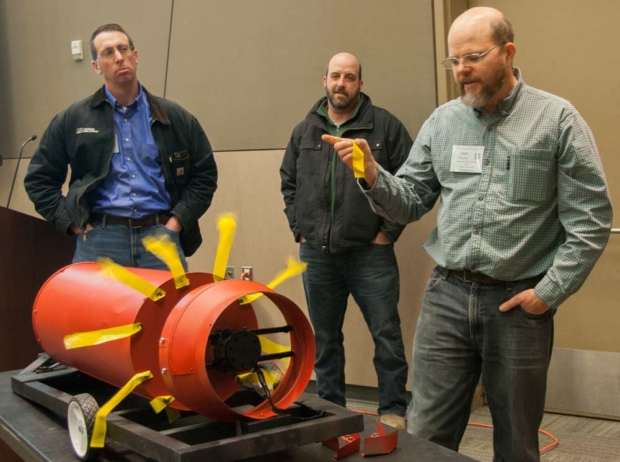Things were a little quieter on the final day of the Great Lakes Fruit, Vegetable and Farm Market Expo in Grand Rapids, Michigan, with just a few educational sessions on the schedule and the expo packing up. But apple growers packed a morning workshop on using plant growth regulators for flowering, fruit set, and other aspects of physiology.
The talks followed the season, from floral bud development through pollination to fruit set and thinning.

Michigan State University entomologist Matt Grieshop explains how to optimize airblast sprayer performance for organic fruit growers during a session at the Great Lakes Fruit and Vegetable and Farm Market Expo in Grand Rapids, Michigan, on December 7, 2017. (Kate Prengaman/Good Fruit Grower)
Keith Yoder, a horticulturist at the Virginia Tech Agricultural Research and Extension Center, explained how a new pollen tube growth model originally developed to help organic growers in the Pacific Northwest time thinning sprays should be available for beta testing by Eastern growers next year.
Then, Phil Schwallier of Michigan State University and Duane Greene of the University of Massachusetts presented the carbohydrate balance and precision thinning models growers can use to plan the timing and rate of chemical thinners and assess their efficacy.
“This information is power,” Schwallier said. “You can use it in two ways, to predict what you would do and to see if your thinner worked.”
During an afternoon session on organic fruit production, entomologist Anne Nielsen of Rutgers University discussed strategies for brown marmorated stink bug control. “This is a difficult pest to manage conventionally,” she said, so organic growers need to use every tool they can.
Nielsen shared data on her recent experiments using a “trap crop” to lure the BMSB to something like sunflowers or sorghum and away from the primary crop, but she found that the strategy only worked for a little while and then pests move on. It would be better to treat that trap crop with pesticides, she recommended, adding that they plan to redesign the study.
The most effective organic pesticides for BMSB include Pyganic + Surround, Venerate, and M-pede, Nielsen said, but they products works slowly and don’t kill all the bugs.
Lastly at the organic session, MSU entomologist Matt Grieshop and research assistant Jacob Emling discussed how to properly calibrate a radial airblast sprayer, which is especially important for organic so they aren’t wasting expensive products with overspray.
Using a small demonstration spray, Emling showed growers how to use flagging tape to see where spray is going and how fan speeds and sprayer modifications can change the air volume and canopy coverage. He also demonstrated how to use a combination of a rubber liner from a milking machine and a graduated cylinder to measure how much product each nozzle is actually delivering, without getting soaked.






Leave A Comment